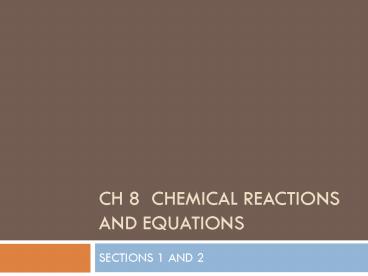CH 8 Chemical Reactions and Equations - PowerPoint PPT Presentation
1 / 20
Title:
CH 8 Chemical Reactions and Equations
Description:
CH 8 CHEMICAL REACTIONS AND EQUATIONS SECTIONS 1 AND 2 Chemical Change One or more substances changes into one or more new substances. Evidence: Changes in energy ... – PowerPoint PPT presentation
Number of Views:240
Avg rating:3.0/5.0
Title: CH 8 Chemical Reactions and Equations
1
CH 8 Chemical Reactions and Equations
- SECTIONS 1 AND 2
2
Chemical Change
- One or more substances changes into one or more
new substances. - Evidence
- Changes in energy
3
Chemical Change
- Evidence
- Formation of new substances
- ________ (bubbles in solution, pressure change
in a closed system) - _________(a cloudy solid that settles out of
solution) - _________ change
- _________change
4
Collision Theory of Reactions
- Chemicals must come into contact (________)
- The contact must be in the correct orientation
(___________________) - There must be enough energy for the reactants to
get started (________________)
5
Chemical equations
- Equations are used to describe chemical processes
- Equations show physical states of matter (s, l,
g) and some reaction conditions.
6
- In words
- Solid magnesium and oxygen gas when heated, react
to form solid Magnesium Oxide.
7
Symbols used in chemical equations
- Pt
- ?
- ( ) Solid
- ( ) Liquid
- ( ) Gas
- ( ) aqueous
- ?
- ?
8
2 arrows means reversible reaction
- Reversible reaction goes both waysThe
products form, and can un-form - Most reactions that happen in your cells are
reversible reactions
9
Elemental forms
- Exceptions
- Diatomic Gases
- Non Gases
- Most elements come naturally in ones
- Ex.
- Sodium Na
- Magnesium Mg
- Iron Fe
10
Write unbalanced equations for the following
- Aqueous Sodium Hydroxide and hydrogen chloride
gas - React to form
- Water and aqueous Sodium Chloride
- Unbalanced means dont put any coefficients
11
Write out this reaction using symbols
- Solid Lithium reacts with water, forming lithium
hydroxide solution and Hydrogen gas.
12
In a reaction
- Mass is neither created nor destroyed.
- Your bag was a closed system. No atoms were
added or removed. They were rearranged. - Law of Conservation of Mass
13
Rules for Balancing Equations
- Count the number and type of each element on the
reactants side. Do the same for the products
side. - Check to see if there are any elements not in
balance. - Use coefficients to balance any elements that are
not equal. - Coefficients affect all parts of the molecule
that follows.
14
__ N2 __ H2 ? __ NH3
- Coefficients
- multiply through the whole molecule.
- Must be a whole number
- Are placed in front of molecules not between.
15
Write balanced equations for the following
- Sodium Hydroxide and hydrogen chloride
- React to form
- Water and Sodium Chloride
16
Balance this reaction
- Lithium reacts with water
- Forming lithium hydroxide and Hydrogen gas
17
Write the equation and balance it using
coefficients
- Lithium reacts with oxygen
- To produce Lithium oxide
- Silver Nitride is produced when silver metal
reacts with nitrogen from the atmosphere.
18
Warm Up
- How many Oxygen atoms are there in each of the
following compounds? - NO2 _______
- 2 NO2 _____
- 2 Mg(NO3)2 _______
19
Balance the following
- Li H2O ? LiOH H2
- C6H12O6 O2 ? H20 CO2
20
Warm Ups
- What is the mass of 1.204E24 molecules of Oxygen
gas? - How many formula units are there in 50.0g of
Magnesium Chloride? - How many atoms are there in the same amount of
MgCl2?































